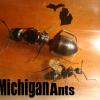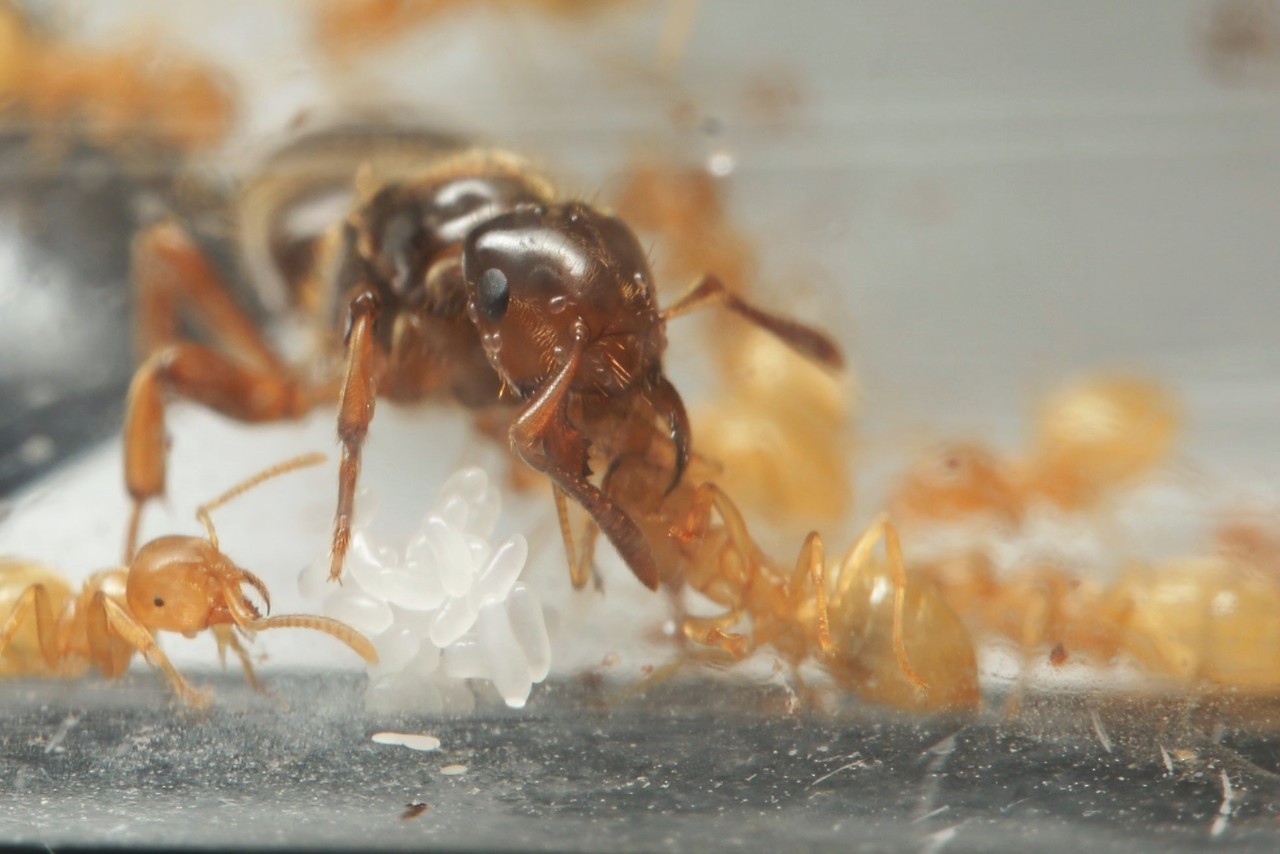In Formicidae, temporary social parasitism describes ants that must start their colony with the aid of workers from another species of the same genus, but will eventually become independent. This is usually undertaken by a parasitic queen replacing the living or deceased queen of a host colony, taking advantage of the host's entire workforce and convincing the resident workers that the parasitic queen deserves to be the colony's only reproductive. All of the reproductive ants that happen to be in the host colony (including the mother queen) are often killed and eaten. The workers of the parasitic species gradually replace the original members of the host colony, until only the parasites remain, taking over all responsibilities for the nest.
Social parasites can typically be distinguished from claustral species by their broader heads (usually broader than the mesosoma) and reduced gaster. The large head is presumably to give the queen an advantage over her host species when she needs to defend herself. The gaster is likely smaller because the parasitic lifestyle does not require large stores of nutrients; when queens' gasters get smaller, the resources required to develop a queen go down and the number of virgin queens a colony can sustain goes up.
There still exists some genera in taxonomy which are exclusively parasitic, but we will likely find these ants revised someday to be with their host genus, which has already occurred with Anergates and Protomognathus. The vast majority of social parasites evolved from their host.
Almost 1/3 of the species in the genus Lasius are socially parasitic, and they are arguably the most encountered social parasites in the Northern Hemisphere. The Lasius subgenera break up these particular parasites into four basic kinds:
Subgenus Acanthomyops

Lasius interjectus, by Alex Wild
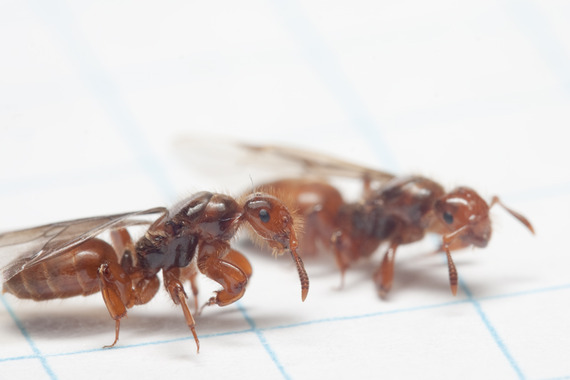
Lasius latipes
Subgenus Acanthomyops:
North America:
Lasius claviger, Lasius latipes, Lasius murphyi, Lasius interjectus, Lasius subglaber, Lasius arizonicus, Lasius californicus, Lasius coloradensis, Lasius mexicanus, Lasius bureni, Lasius colei, Lasius creightoni, Lasius pogonogynus, Lasius occidentalis, Lasius pubescens
Lasius from the Acanthomyops subgenus are endemic to North America and commonly referred to as “citronella ants”. Colonies subsist almost entirely underground, on populations of root aphids. Their queens are typically large, shiny, and orange or brown, they have somewhat broad legs and antennae (Lasius caliveger and Lasius interjectus) up to very broad (Lasius latipes). Their bodies tend to have many long, standing hairs, and very little in the way short, fine hairs.
It's been observed that dealated queens like to band together in groups of three or more, although it is worth mentioning that captive Lasius are very rarely polygynous. It's been noticed that they survive much longer when they are fed tiny specks of sugary liquid inside the test tube.
On of the potential difficulties in raising queens from this subgenus may trace all the way back to their mother's nuptial flight. Acanthomyops frequently hybridizes, which, in Formicidae, often begets reproductively unviable queens (although the workers are quite functional, and males produced by the queen will only contain her DNA). It is believed that males breed interspecifically as a form of reproductive parasitism, greatly inhibiting the ability to create subsequent generations by affected Acanthomyops queens. Many Acanthomyops spp. are competing to infiltrate colonies of the same host species.
Subgenus Chthonolasius
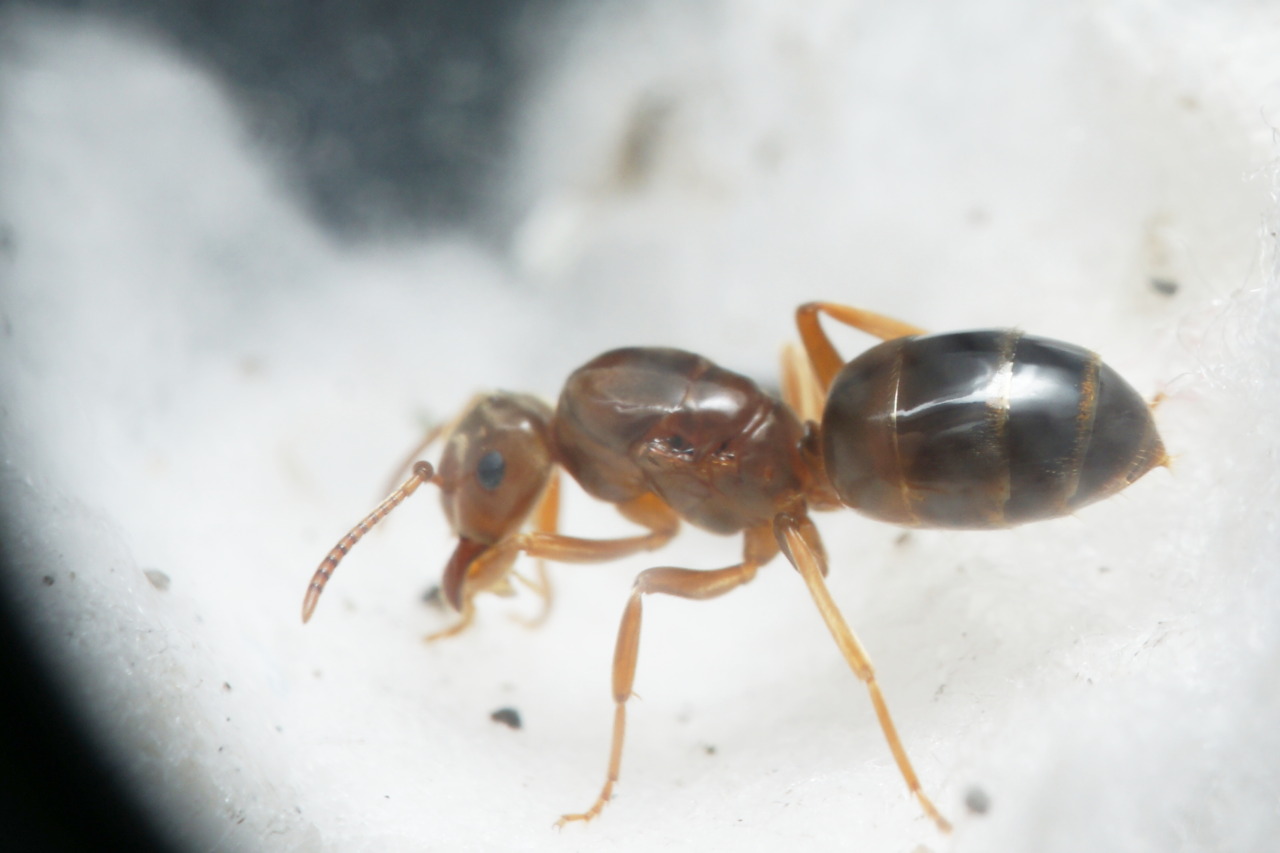
Lasius speculiventris

Lasius subumbratus
Subgenus Chthonolasius:
North America:
Lasius aphidicolus, Lasius speculiventris, Lasius minutus, Lasius subumbratus, Lasius vestitus, Lasius nevadensis, Lasius atopis, Lasius humilis
Eurasia:
Lasius umbratus, Lasius mixtus, Lasius balcanicus, Lasius bicornis, Lasius citrinus, Lasius distinguendus, Lasius jensi, Lasius meridionalis, Lasius nitidigaster, Lasius rabaudi, Lasius sabularum, Lasius viechmeyeri
Chthonolasius are present in most of the Northern Hemisphere. Wild colonies largely survive off of root aphids, as with other yellow Lasius, but workers have large eyes and are not afraid to occasionally forage above ground. Their alarm pheromones do not differ much from other Lasius, so a citronella odor is generally indistinct or absent in preference of formic acid. Queens are usually smaller than typical Lasius (L. subumbratus being one notable exception) and are more dull than Acanthomyops. Their coloration is often brown to orange. Some species of this subgenus are known to build cartonous galleries, using a type of Hormiscium pithyophilum fungus to glue grains of sand together, supposedly fed on aphid excretions.
These ants are much more agreeable in captivity, compared to Acanthomyops in North America. Queens will very usually begin laying eggs within one month after having host workers. The length of time it takes for the first parasitic workers to eclose varies with the level of care from the host species. Niger-group Lasius are best suited this, in my experience. Colonies of Chthonolasius will thrive given the same care as their claustral cousins.
Subgenus Dendrolasius
Lasius fuliginosus, by Lebon Lionel
Subgenus Dendrolasius:
Eurasia:
Lasius fuliginosus, Lasius buccatus, Lasius capitatus, Lasius spathepus
Queens of the Eurasian Dendrolasius typically have dark, shiny bodies with lighter appendages and a distinctly convex depression at the top of the head. These ants are well known to be hyperparasites of Chthonolasius in the wild, and seem doubly enthusiastic about carton-building. Colonies largely subsist on aphid secretions, but are seemingly more arboreal than their usual host. Similar to Acanthomyops, these ants utilize a citronella odor. Colonies sometimes use the budding strategy during reproduction, a share of workers and one or more queens moving to a separate nest area. Unlike the other parasitic Lasius, workers are black.
Despite their hyperparasitic reputation, Dendrolasius colonies can easily be founded using other Lasius in captivity, and have foraging habits similar to Chthonolasius, although the founding process may sometimes fail unforeseeably.
Subgenus Austrolasius

Lasius carniolicus, by Will Ericson
Subgenus Austrolasius:
Eurasia: Lasius carniolicus, Lasius reginae
Little is known about these root-aphid tending social parasites, except that the queens are only barely larger than her workers at less than 4mm. They often parasitize Lasius alienus in the wild. Because of her morphology, she might depend on a different founding strategy from these other, robust Lasius.
The Basics:

Orphaned workers from our captive colonies, like these Lasius americanus, may be used as the host to begin a new colony.
One of the most important things to note about Lasius social parasites is that queens are not capable of caring for brood or opening pupae before they have host workers. They will not lay eggs without host workers. In order to start a colony, a queen will need to be introduced to workers from a foreign nest, which are from the same genus. We don't quite understand how significant the species is, although some paraites (i.e. Lasius speculiventris) seem to be particular (they have only been found in the nests of another social parasite, Lasius minutus.) Myrmecologists have only been able to truly confirm a host species when they find a nest which houses two different kinds of workers.
When taking a sample of host workers to introduce to your queen directly, always try to choose those who are living inside of the nest. The ants in charge of brood care are the youngest in the colony, and younger ants are the least aggressive. Ideally, your workers would be coming from another colony you already care for, but these younger workers can be found in the wild under judiciously flippable stones. Be conscientious about the impact you are having on any wild nest.
Make sure not to add any test tube substrates (i.e. coconut fiber) to the parasite/host colony setup until the queen is adopted to host workers. Otherwise, she may seal herself off from the young workers long enough for them to become aggressive.
Colony Founding Techniques
(For the most reliable founding technique, see the callow method at the bottom of this list)
Active, naturalistic introduction:
A sample of at least 20 host workers and (ideally) some brood are kept in one test tube setup, the parasitic queen(s) kept in another test tube setup.
Both tubes are placed close to each other in a foraging arena and left opened.
The parasitic queen(s) will eventually encounter one or more of the workers, which will likely latch onto her in an attempt to kill her. The queen will often retreat to her tube to kill and remove any workers. She will lick the worker's corpse and groom herself, presumably spreading the worker's hydrocarbons over her body.
The queen may wait for some time before seeking out the host workers again, but this second encounter is often much friendlier.
Pros:
Uncomplicated, least human involvement.
Ants are not subjected to abnormal environmental hazards.
Queens have space to retreat from hostile workers.
Cons:
Risk of injury or death to workers and/or queens.
Older workers will almost always be hostile on the first encounters with the queen(s).
Active, naturalistic introduction -- the pre-killed worker variant:
One worker from the host sample is crushed and placed in the sealed tube with the parasitic queen(s). If the queen expresses interest in the corpse, licks the body and grooms herself, it can be assumed that she intends to infiltrate that colony.
Both tubes are placed close to each other in a foraging arena and left opened.
Pros:
Poses less danger to the queen; colony odor can be secured and administered in a safe environment.
Cons:
At least one worker is always sacrificed, but this is likely a better outcome than if the queen were left to do this on her own.
The chilling method:
A sample of at least 20 host workers and (ideally) some brood are kept in one test tube setup, the parasitic queen(s) kept in another test tube setup.
The tube containing the host sample is placed in refrigeration, but well above freezing temperatures.
The tube containing the queen is adjoined to the chilled host sample, or the queen is placed inside the chilled host colony tube.
All of the ants remain in refrigeration until the queen and workers come together as a colony.
Pros:
This method has the potential to introduce a queen to a host sample without any casualties.
Aggressive workers are sedated by cold temperatures.
Cons:
The risks associated with refrigeration (i.e. condensation, flooding, physiological disturbance) pose a danger to ants and brood.
The queen has nowhere to escape to if the workers prove too much to handle.
The callow method:
A small sample of host workers and a manageable number of pupae are kept in a test tube setup in such a way that a fine paintbrush or toothpick can reach all the way to the wet cotton bung. The queen(s) are kept in another test tube setup.
The worker's tube is given access to a small foraging arena so they may feed themselves.
As pupae mature, the host workers will open up the cocoons to eclose young, callow workers.
After a callow ecloses, very carefully and gently coax the callow onto your paintbrush or toothpick and remove her from her sisters. If any mature workers come with her, place those back in the tube.
The callow worker is introduced to the social parasite queen. There is unlikely to be any hostility. Offer a tiny sugar meal.
After the parasitic queen has a decent number of workers, boost the her with some more of the host's brood. The original adult host workers (that you did not introduce) can be released back to their colony, and the callow workers can take over brood care.
Pros:
This method has the potential to introduce a queen to a host sample without any casualties.
Callow workers are not aggressive, and will imprint upon the queen.
Cons:
It can take some time. If the social parasite species is prone to mysterious death, this can happen while the queen is alone in her tube. Make sure she gets the opportunity to feed, but keep the tube clean.
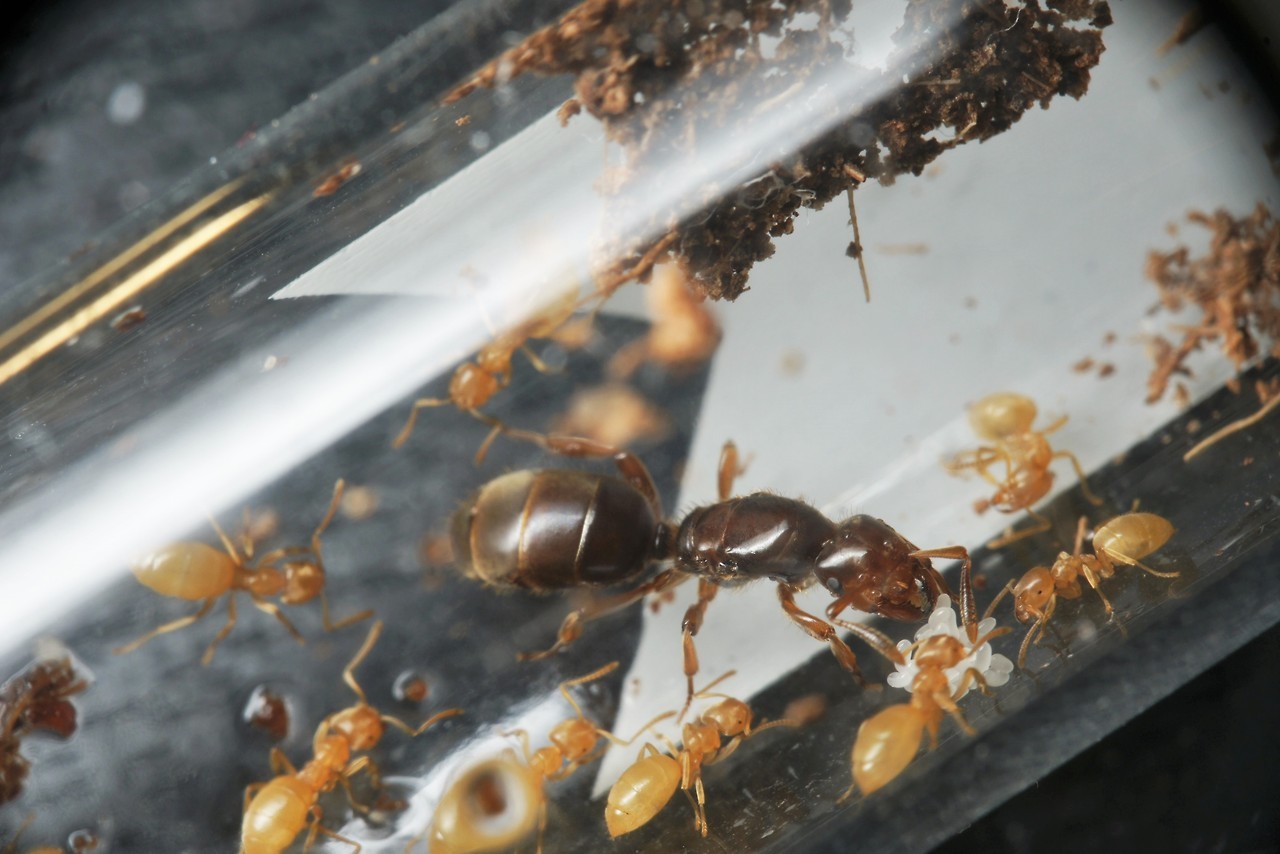
Lasius latipes with Lasius cf. nearcticus host workers and eggs
It can days, weeks, or months before your queen begins to lay her first eggs. There could be something going on behind the scenes during this time; for whatever reason, a parasitic queen with a usurped colony will not always begin laying straight away. Once she has her first egg, however, the most difficult phase of her life is basically over; it is a sign not only that she is fully accepted by her host workers but that she is adapted to captivity, in good health, and is finally ready to begin her colony. While there are still a few hurdles to overcome, you can now relax or celebrate. Since your queen already has a selection of host workers to keep her fed, she will begin to produce eggs to match the hypothetical age of the colony (a 50 host worker colony will cause her to lay eggs as if she is already about one year old, etc.)
One thing that can be said for temporary social parasitism is that while a queen will get a huge amount of free labor, it isn't exactly of the best quality; it's a rather tumultuous time in the colony's life. During the early stages, host workers are rather aggressive, careless, or confused when they interact with members of the parasite species (and vice versa.) Brood of one species can be eaten or neglected by the other. Workers will be bullied and occasionally killed to be fed to the larvae. These behaviors may be an immunity response of the host species to the ants who parasitize them. Once the first parasite worker successfully matures, the situation usually changes for the better.
Resources:
Sperm Parasitism in Ants: Selection for Interspecific Mating and Hybridization
Resources (Free Access):
Colony Founding of Acanthomyops murphyi, a Temporary Social Parasite of Lasius neoniger
Experiments on the Adoption of Lasius, Formica, and Polyergus Queens by Colonies of Alien Species
Edited by Batspiderfish, August 18 2018 - 7:12 PM.






